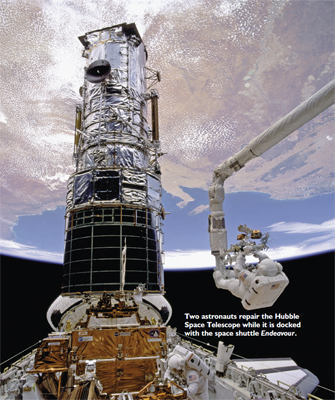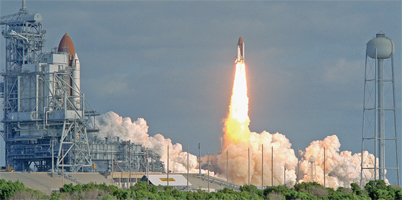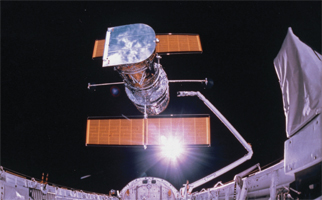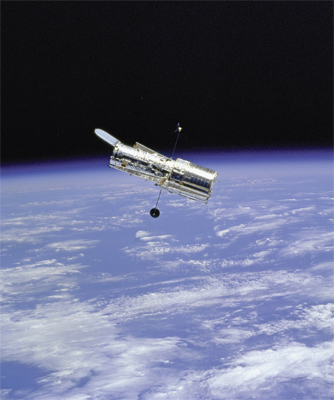

The Hubble Space Telescope was carefully loaded into the payload bay of the space shuttle Discovery. Astronomers, engineers, and other scientists had spent fifteen years designing and building the mighty telescope. At long last, it was ready for its journey into space. In the middle of April 1990, Discovery and its long-awaited cargo rolled slowly to the launchpad at Cape Canaveral, Florida.
The giant telescope had cost more than $1.6 billion! Scientists had faced many problems in constructing the telescope. Most of them believed their years of difficult effort were worth it. If the telescope worked, it would be the most powerful telescope ever built.
Finally, the day for which these scientists had long been waiting had arrived. Discovery sat on the launchpad with the Hubble Space Telescope inside, ready for its historic ride into space.
As the countdown continued, those who had worked on the telescope watched and listened. If all went well, Discovery’s crew of astronauts would release the telescope into orbit the following day. Strapped to their seats, the astronauts listened to the countdown on their helmet headsets.
T minus one minute and counting . . .
Like the thousands of people who had worked on the telescope, the astronauts braced themselves for the approaching moment of liftoff.
The final seconds ticked down.
Five . . . four . . . three . . . two . . . one . . .
Orange fire and huge clouds of smoke gushed outward from Discovery’s engines. The tremendous thrust lifted the space shuttle off the launchpad.
“ . . . And liftoff of the space shuttle Discovery,” the NASA announcer said, “with the Hubble Space Telescope—our window on the universe.”1
Discovery roared through the sky toward space. As it climbed higher and higher, the solid rocket boosters and the external fuel tank separated from the shuttle. Minutes later, the shuttle was in orbit.
The next day, Discovery’s crew opened the payload bay doors. The Hubble Space Telescope, named after American astronomer Edwin Hubble, was then released into orbit around Earth.
It was more than three weeks before the telescope’s instruments were ready to look at their first object in space. After all the waiting, astronomers had high hopes for this amazing machine.
Astronomers had long wanted a telescope in space. The biggest reason for such a telescope was simple: All light from space that reaches a telescope on the ground is blurred by Earth’s atmosphere. A telescope in space, above Earth’s atmosphere, would be able to see objects in space much more clearly. Without the blurring effect of Earth’s atmosphere, it would also be able to see much farther out into space.
The most important part of the Hubble Space Telescope was an eight-foot-wide mirror. This primary mirror was designed to focus on distant objects in the universe like never before. Light from a distant star or galaxy would reflect off this large mirror and onto a series of smaller mirrors, bouncing the light into what was called the Wide Field Planetary Camera, or WF/PC. Because of this abbreviation, everyone called the camera the “wiff pic.”2

Discovery lifts off from the launchpad at Cape Canaveral, Florida, on April 24, 1990, carrying the Hubble Space Telescope in its payload bay.
The WF/PC records the object’s image and stores it in a computer. The computer then relays the image to the Space Telescope Science Institute in Baltimore, Maryland, where a team of astronomers studies it.
Many highly complex scientific instruments for measuring the mirror’s reflected light were placed aboard the Hubble Space Telescope. The Faint-Object Camera was designed to take pictures of dim objects in space that can barely be seen from Earth. The Faint-Object Spectrograph would examine the different colors of light coming from these objects. By this method, scientists could learn the object’s temperature, as well as its chemical and gas makeup.3 The Goddard High-Resolution Spectrograph would look at objects in space, focusing on a special kind of radiation called ultraviolet light. Ultraviolet light is invisible to human eyes. The Hubble Space Telescope would give scientists a great new opportunity to observe this type of light from space.4 The brightness of light coming from a star or galaxy would be measured by the High-Speed Photometer. This measurement would help astronomers learn about the size of the object in space, as well as its distance from Earth.
While the Hubble Space Telescope is a telescope, it is also a spacecraft. It is powered by a set of solar arrays attached to either side of the telescope. Its guidance system is used to point the telescope in the direction of the object scientists wish to view. This system is very important. The many powerful instruments aboard the Hubble would be useless if scientists were unable to aim and focus the telescope effectively.

Hubble, shown in this diagram, is not only a telescope, but also a spacecraft. Its guidance system allows scientists to point the telescope at objects they wish to view.
By May 20, 1990, the Hubble Space Telescope was ready to be aimed at its first target in space. The engineers, astronomers, and other scientists involved with the project believed the telescope’s systems were ready for operation. Hundreds of these scientists gathered in control rooms at the Goddard Space Flight Center in Greenbelt, Maryland; the Marshall Space Flight Center in Huntsville, Alabama; and the Space Telescope Science Institute.
Reporters from newspapers and radio and television stations were there with the scientists to watch the first images from the new telescope. The press had carried many stories about the telescope during all the years it was being built. The public’s expectations for the telescope were high.5
Controllers at the Goddard Space Flight Center sent a set of commands to the telescope. Orbiting 375 miles above Earth, the telescope responded, turning slowly to catch the light from a star cluster 1,300 light-years away. It was the star cluster NGC 3532.
The light from the distant star cluster hit the primary mirror, bounced up to the smaller secondary mirror, and traveled back through the central opening in the primary mirror. The twice-reflected light then bounced off another mirror and into the WF/PC, which recorded the image. All was going according to plan.
The scientists who had gathered at the three centers knew the telescope had received its aiming commands. For several minutes, all of them waited anxiously for the image to appear on their computer screens.6
The orbiting telescope then came into the range of a data relay satellite. The telescope sent its data to the satellite, and the satellite relayed them down to Earth. Computers at the Goddard Space Flight Center received the data and transformed them into a picture, which was seen by scientists, reporters, and engineers at the Space Telescope Science Institute as well.

In this photo, a robotic arm from Discovery holds the Hubble Space Telescope while it is being examined during its inaugural space flight. On May 20, 1990, Hubble was ready to take its first photograph.
A fuzzy group of stars appeared on the screen. People in the rooms grew excited as the camera team processed the image through a set of computer programs that slightly sharpened the picture.
“Look at that!” some of them shouted.
“It works! Hubble works!” said others.7
The press reported this first image from the Hubble Space Telescope as a great success. Astronomers and NASA officials told the reporters that they did not expect a sharp, clear picture from the telescope the first time it was used. NASA knew it would take days or even a few weeks to get all of the telescope’s instruments adjusted properly.
However, as NASA adjusted the telescope, those days went by with no improvement in the images. No matter what they tried, the images remained blurry.
Weeks passed. The press wanted to know why the telescope was not yet producing amazing pictures of stars and galaxies. NASA scientists tried everything they knew to sharpen the images, but nothing worked.
When the telescope looked at a star, the image it produced had a bright point in the center surrounded by a strange blurry halo. NASA then put the telescope through a test that moved the primary mirror through its entire range of focus—very much like twisting the focus ring on a camera. As the primary mirror was moved from one end of its focus range to the other, it never produced a sharp picture.
This test led NASA scientists to a terrible conclusion: There was a flaw in the telescope’s primary mirror.
The primary mirror had started out as a one-ton piece of optical-quality glass. Over a period of three years, two hundred pounds of the glass were carefully ground and polished away, until its shape was considered perfect to reflect the light from space. But something had gone wrong.
There was no way to ignore the evidence coming from Hubble. Scientists were stunned when they realized the problem was with the eight-foot primary mirror—the very heart of the telescope.

NASA scientists rejoiced when Hubble successfully transmitted its first image. However, weeks later, they still had been unable to focus the image. Soon, scientists discovered there was a flaw in the telescope’s primary mirror. In this photo, workers study Hubble’s eight-foot mirror prior to the launch in 1990.
The primary mirror had been ground and polished incorrectly. It suffered from what astronomers called a spherical aberration. One edge of the mirror was ten-thousandths of an inch too flat, a measurement one-fiftieth the width of a human hair. This measurement is invisible to the human eye.8
No matter how small the flaw, the result was that the telescope’s mirror could not focus light into a sharp point.
The Hubble Space Telescope, the most powerful telescope ever built, could not be focused.
The high hopes for the Hubble Space Telescope had been shattered. The project quickly became a huge source of embarrassment to NASA. The press harshly criticized them for the expensive failure. It was not long until the blurred space telescope became a source of jokes for comedians and cartoonists.

A view of the Hubble Space Telescope prior to the launch in 1990. NASA spent $1.6 billion to build and launch Hubble, but the telescope still did not work properly. NASA needed to plan a daring repair mission in order to salvage the telescope.
What could be done to fix a broken telescope that had already cost NASA $1.6 billion to build and launch into space? Scientists could not simply climb into it and fix it. It was in space, in orbit around Earth. The first scheduled mission to service the telescope was not for another four years!
The flaw in the primary mirror was not the telescope’s only problem. As the telescope orbited from the light to the dark sides of Earth, the heating and cooling of the solar arrays caused the telescope to wobble. The guidance system was also having problems pointing the telescope at the correct objects in space.
NASA scientists began thinking of ideas that might solve the telescope’s problems. Some at NASA wanted to capture the telescope with the shuttle and bring it back to Earth for repair. Others believed such a plan would not work. Once the telescope was back on the ground, they believed there would be no support from the public to repair it and get it back into space again.9
It was clear that a daring mission to repair the telescope in space would have to be planned.
NASA designed a complex repair mission and built special tools that scientists believed could be used to correct the focus of the primary mirror and fix the guidance system.
Only a repair in space could save the Hubble Space Telescope.

NASA’s ambitious mission to repair the Hubble Space Telescope required a team of astronauts to fly into space and make the repairs manually. A space shuttle carrying the astronauts would have to dock with the telescope as it orbited the Earth.